Tag archives: China
Probing the quantum nature of water
By James Dacey in Beijing on Friday 4 November
After enjoying clear blue skies for the first couple of days of my visit to Beijing, the breeze has disappeared and the smog has taken its hold. One local scientist told me this latest wave is due to pollution from factories south-west of the city, but others have told me it is difficult to pinpoint a particular source. Facemasks are being worn by every other person in the streets, but fortunately I’ve been sheltered by the walls and ceilings of Peking University (PKU).
View all posts by this author | View this author's profile
Science elevator pitches in Beijing
By James Dacey in Beijing
Could you provide a short entertaining presentation of your research to a non-specialist audience, leaving them feeling both enlightened and inspired? How about trying to do it in a non-native tongue? That’s what several Chinese researchers did on Wednesday evening at the Science Slam event at the European Delegation headquarters in Beijing. The event was part of a day-long communications training workshop aimed at researchers who want to communicate their research to the general public and improve their ability to apply for research grants.
View all posts by this author | View this author's profile
Computing in a chilly Beijing
By James Dacey
Today is my first day in Beijing and boy am I glad I packed my winter coat. Despite the clear blue skies, it was just above freezing point as I arrived at the Beijing Computational Science Research Center (CSRC) this morning, with an icy wind bringing an added chill factor. I was with my IOP Publishing colleague Tom Miller as we were delivering a presentation about scientific publishing and journalism and our taxi driver decided that 2 km from the venue was as far as he fancied going. So a brisk walk later we arrived with chattering teeth in need of a thorough thaw.
Located a few kilometres north-west of Beijing’s centre, the CSRC is within the Zhongguancun hi-tech zone. The majority of buildings within the technology hub are occupied by commercial firms, and our icy walk took us past the impressive modern offices of Baidu and Lenovo among other companies. The CSRC, however, is focused primarily on the application of computational modelling to fundamental science research. Its seven divisions include physical systems, quantum physics & quantum information, and materials & energy.
View all posts by this author | View this author's profile
Physics World Special Report: China
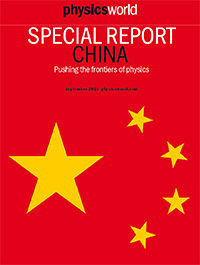 By Michael Banks
By Michael Banks
Physics World published its first special report on China in 2011, which looked at China’s lunar programme and how the country was tackling fraud, as well as profiling the Kavli Institute for Astronomy and Astrophysics and the Institute for High Energy Physics, which are both located in Beijing.
Five years on and physics in the world’s most populous country has rapidly expanded, with China building a number of other huge facilities – including the China Neutron Spallation Source and the China Jinping Underground Laboratory. Now close to completion, they will put the country at the forefront of physics.
So what better time to have another special report on China? Based on visits to Beijing, Hong Kong and Shenzhen, the issue, which you can read free here, includes an overview of the current state of physics in the country as well as an interview with Wei Yang, president of the National Natural Science Foundation – the country’s biggest investor in basic science – and a piece looking at how scientists can foster good collaborations with physicists in China.
A great day out at the Institute of Physics in Beijing

Weyl theorists: Zhong Fang (left) and Hongming Weng.
By Hamish Johnston in Beijing
This morning I had a wonderful visit to see some condensed-matter physicists at the Institute of Physics of the Chinese Academy of Sciences (IOP CAS). First I met with theorists Zhong Fang and Hongming Weng and if you know your equations you can see from the above photo that they work on Weyl semi-metals. Fang is deputy director of the institute and is head of a theoretical physics group that includes six faculty members and about 20 postgraduate students. Avid readers might recall that Fang and Weng were named in the Physics World Top 10 Breakthroughs of 2015 for their work on Weyl fermions.
View all posts by this author | View this author's profile
Entrepreneurs should practise ‘inclusive knowledge transfer’
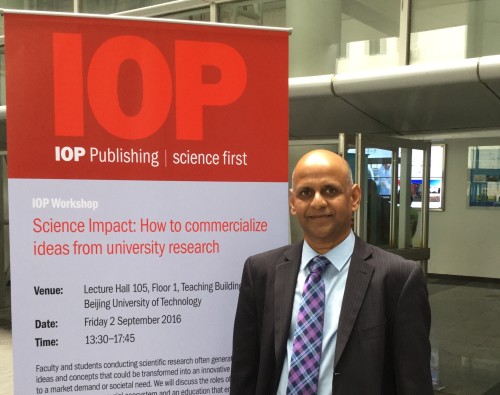
Ethical entrepreneur: Surya Raghu in Beijing.
By Hamish Johnston in Beijing
“90% of new products are targeted at the richest 10% of the world’s population” – that’s my take-home message from a fascinating presentation by Surya Raghu at the Fall Meeting of the Chinese Physical Society here in Beijing. An engineer by training, Raghu founded US-based Advanced Fluidics in 2001 after a career in academia.
Raghu was speaking to a group of Chinese students about how to embark on a career as an entrepreneur. Student-age is the best time to acquire the mindset of an entrepreneur, says Raghu and he emphasized the concept of “inclusive knowledge transfer”. This a way of ensuring that products developed at universities benefit even the most disadvantaged in the world.
View all posts by this author | View this author's profile
China’s quantum star drops into Beijing
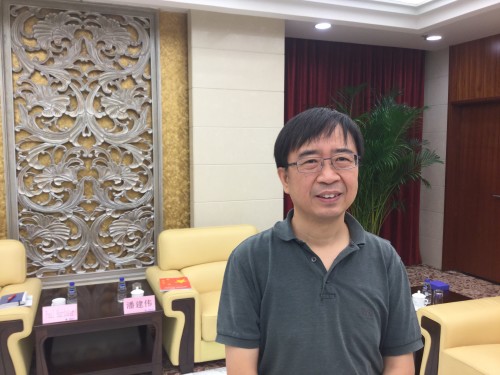
Quantum star: Jian-Wei Pan before his television appearance.
By Hamish Johnston in Beijing
A few weeks ago China launched the world’s first “quantum satellite” from the Jiuquan Satellite Launch Center, which about 1600 km from Beijing. This morning I met the lead scientist on the mission, Jian-Wei Pan of the University of Science and Technology of China, who is visiting Beijing on his way home to Hefei from Jiuquan.
I asked Pan how the mission (called QUESS) was going, and in particular if his team has managed to get the satellite to send entangled pairs of photons back to Earth. He said we would have to wait for the team to write a paper about the satellite’s initial performance – so let’s just say he was in a very good mood! Stay tuned for more information about this pioneering mission that could lead to quantum communications in space.
View all posts by this author | View this author's profile
How to use a mountain to detect neutrinos
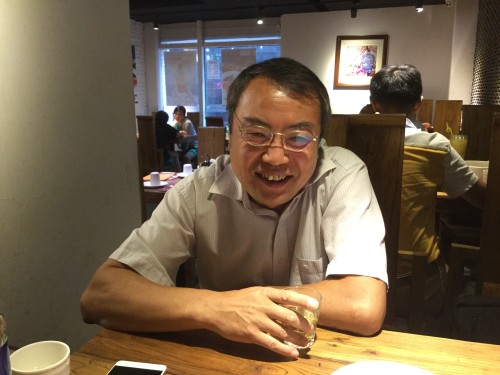
Aiming high: Zhen Cao explains how to use a mountain to detect tau neutrinos.
By Hamish Johnston in Beijing
This evening I had dinner with Zhen Cao, who is one of China’s leading particle astrophysicists and works at the Institute of High Energy Physics of the Chinese Academy of Sciences here in Beijing.
Cao has found a great way to combine his passion for mountains and neutrinos: the Cosmic Ray Tau Neutrino Telescope (CRTNT), which, if built, will use an entire mountain in western China as a cosmic neutrino detector.
View all posts by this author | View this author's profile
A physics tour of Beijing

Dusk falls on Beijing.
By Hamish Johnston in Beijing
It’s a lovely warm evening here in Beijing. I have just arrived for an action-packed visit in which I will have a chance to meet some of China’s top physicists and science policy makers.
Over the next few days I’m looking forward to meeting people at the Chinese Physical Society (CPS), the China Association for Science and Technology (CAST), the Ministry of Science and Technology of China (MOST), the National Natural Science Foundation of China (NSFC) and more.
View all posts by this author | View this author's profile
Chatting about Chinese computing
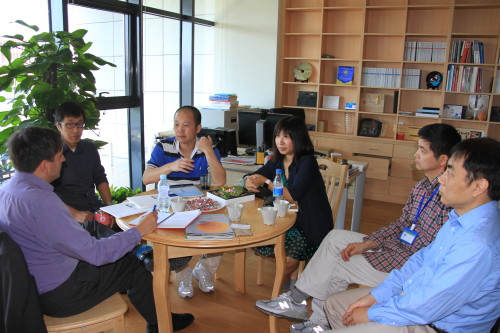
Calculated efforts: Matin Durrani (far left) in conversation with staff at the Beijing Computational Science Research Center, including Hai-Qing Lin (third left). (Courtesy: Mingfang Lu)
By Matin Durrani in Beijing, China
The last couple of days in the Chinese capital have been unusually damp and cool for the middle of June. Today, however, dawned sparklingly sunny as I headed off with my colleague Mingfang Lu from the Beijing office of the Institute of Physics, which publishes Physics World, to the Beijing Computational Science Research Center (CSRC) on the outskirts of the city.
Located on a shiny new software park, this sleek, five-storey building opened in March last year and looks just how you might expect the headquarters of IKEA to be – all minimalist corridors, big glass windows and the odd work of art dotted around. There’s even a fitness room in the basement. It’s currently got 43 full-time faculty, a third of whom are physicists, making this 45,000 m2 building – roughly the size of seven football pitches – seem remarkably sparse.
View all posts by this author | View this author's profile
